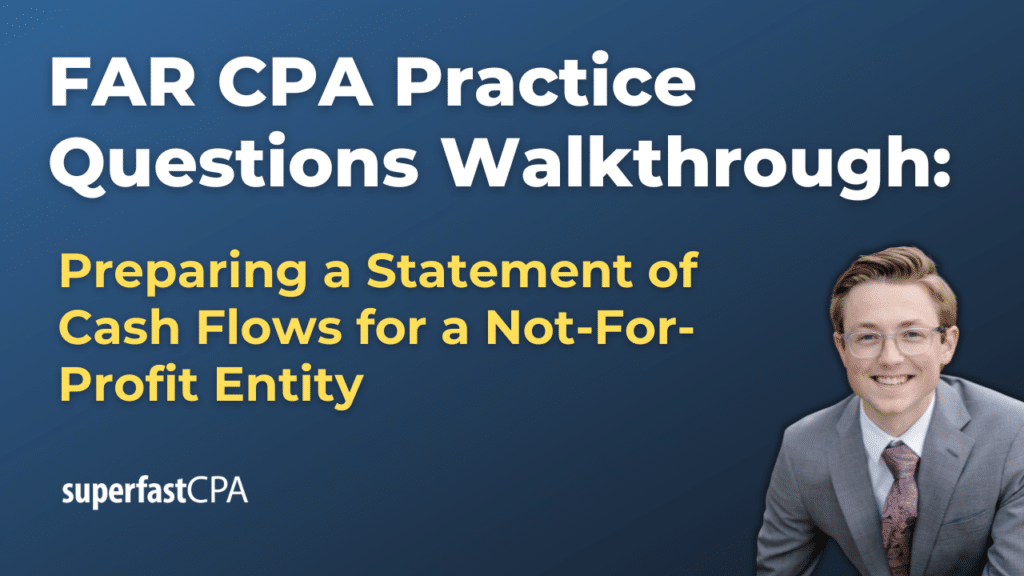In this video, we walk through 5 FAR practice questions teaching about preparing a statement of cash flows for a not-for-profit entity. These questions are from FAR content area 1 on the AICPA CPA exam blueprints: Financial Reporting.
The best way to use this video is to pause each time we get to a new question in the video, and then make your own attempt at the question before watching us go through it.
Also be sure to watch one of our free webinars on the 6 “key ingredients” to an extremely effective & efficient CPA study process here…
Preparing a Statement of Cash Flows for a Not-for-Profit Entity
The statement of cash flows is an essential component of financial reporting for nongovernmental, not-for-profit organizations. It provides insights into the entity’s cash inflows and outflows, categorized into operating, investing, and financing activities. This post highlights the aspects of preparing the statement of cash flows, particularly focusing on the nuances relevant to not-for-profit entities.
Classifying Contributions with Donor Restrictions
One of the unique aspects of not-for-profit accounting is the handling of contributions with donor-imposed restrictions. The classification of these contributions in the statement of cash flows depends on the nature of the restriction:
- Financing Activities: Contributions that are restricted by donors for long-term purposes, such as building a facility or creating an endowment, are classified as financing activities. This is because these contributions affect the entity’s net assets, similar to how equity transactions would affect a for-profit company. For example, if a donor restricts a contribution for the purchase of a new building, the receipt of that donation is recorded as a financing inflow.
- Investing Activities: When the restricted funds are actually used to acquire long-term assets, such as purchasing land, buildings, or investments, these outflows are classified as investing activities. Even though the inflow was recorded as a financing activity, the outflow related to the purchase of the asset is considered an investing activity because it involves the acquisition of long-term assets.
Handling the Purchase and Sale of Long-Term Assets
Transactions involving the purchase and sale of long-term assets are consistently classified as investing activities:
- Purchase of Assets: Whether it’s land, buildings, or works of art, the cash outflow to acquire these assets is classified as an investing activity. For example, if a museum purchases a sculpture for its permanent collection, this transaction is recorded as an investing outflow.
- Sale of Assets: The sale of long-term assets, including the sale of investments or equipment, is also classified as an investing activity. Any gain or loss on the sale, however, is typically reported as part of operating activities in the indirect method.
Insurance Proceeds and Long-Term Assets
Another unique scenario involves insurance recoveries for lost or stolen long-term assets:
- Insurance Proceeds: If a not-for-profit entity receives insurance proceeds due to the loss, theft, or destruction of a long-term asset (such as a work of art or a building), these proceeds are classified as investing activities. This classification aligns with the treatment of the acquisition and disposal of long-term assets.
Indirect vs. Direct Method Overview
While this post focuses more on specific transactions, it’s important to understand the broader methods for preparing the statement of cash flows:
- Indirect Method: This method begins with the change in net assets and adjusts for non-cash items, gains or losses on sales of assets, and changes in working capital to calculate the net cash provided by or used in operating activities.
- Direct Method: This method reports actual cash transactions related to operating activities, providing a straightforward view of cash inflows and outflows without adjustments for non-cash items.
Summary
Preparing the statement of cash flows for a not-for-profit entity involves careful classification of various transactions into operating, investing, and financing activities. Contributions with donor restrictions for long-term purposes are recorded as financing activities, while the actual purchase of long-term assets is an investing activity. Proceeds from the sale of long-term assets and insurance recoveries are also classified as investing activities.












